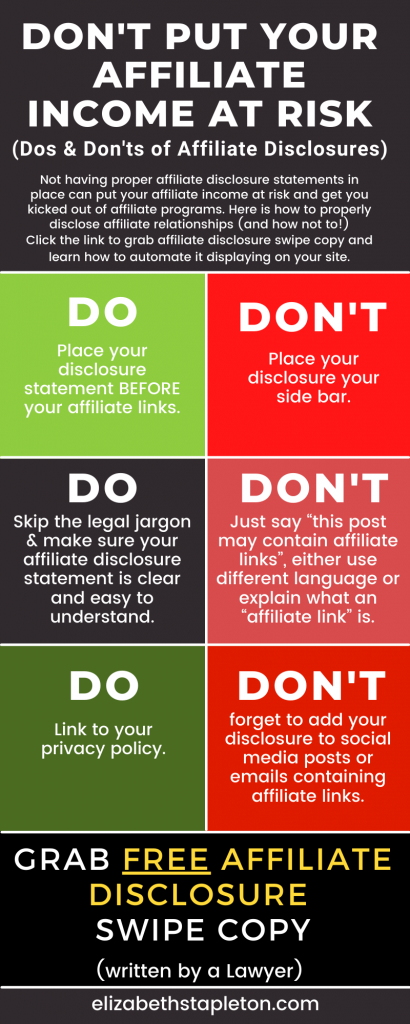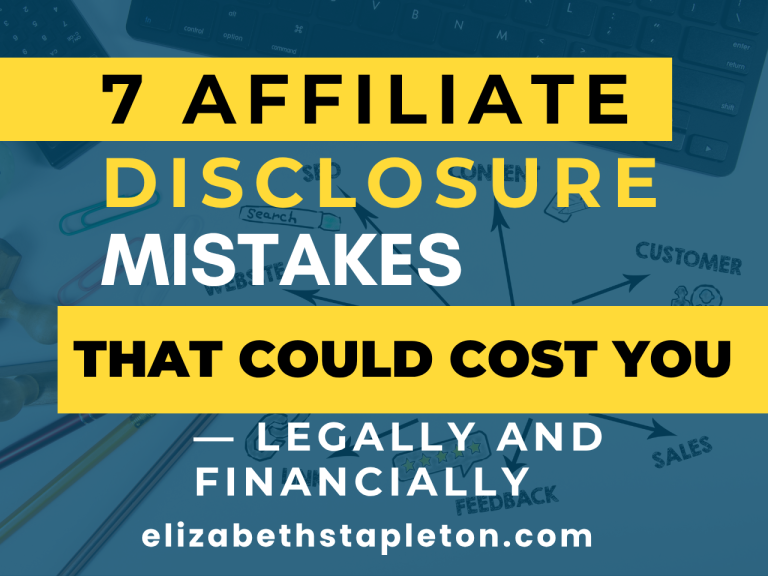Affiliate Disclosure Dos and Don’ts – The Ultimate Guide for Bloggers
Affiliate marketing can be a great way to earn more money. While it can take work upfront, it has the potential to continue earning passively for years.
If you’ve never heard of the term ‘Affiliate Marketing’ you may be wondering what I’m talking about. Don’t worry this guide will not only break down what affiliate marketing is, but also how to make sure you you do it the correct way. Making sure you comply with the Federal Trade Commission (FTC) and don’t put your income at risk.
What is Affiliate Marketing
Affiliate Marketing is an industry term that most people understand as referral marketing.
If you’ve ever signed up to a product and gotten a code to share with friends in return for credit to your account or cash money, you’ve participated in affiliate marketing.
While referral marketing is a great way to earn a bit of extra cash or credit for products you use, there are online businesses that make a full-time living from affiliate marketing.
As you could probably guess, great affiliate marketing involves more than just sharing a link or code with friends and family. There is a lot of strategy involving SEO and analyzing data to see what is working.
What Does the FTC Have to Do With Affiliate Marketing
The Federal Trade Commission (“FTC”) aims to protect consumers from sketchy businesses. Their mission is, “Protecting consumers and competition by preventing anticompetitive, deceptive, and unfair business practices through law enforcement, advocacy, and education without unduly burdening legitimate business activity.” (FTC Website)
The FTC was established by law in 1914, long before affiliate marketing as we see today existed. But the FTC has kept up with the times, in order to protect consumers they require affiliates to disclose the relationship they have with the company or product they promote.
In plain english, if you are receiving any sort of compensation, this could be for example, in the form of payment, free products, or credit, then you must make sure your audience knows.
Really all this legal requirement is doing is requiring is that you be transparent and honest with your audience.
What is An Affiliate Disclosure
An affiliate disclosure is the statement made to notify readers that you (the affiliate) has a relationship (will or has received some kind of compensation) for sharing your special (affiliate) link or code.
Requirements of Affiliate Disclosures
The idea of disclosing an affiliate relationship seems simple enough, but there are certain requirements for the disclosure in order for it to meet FTC standards. These include:
- The language used in the disclosure must be clear and concise
- The disclosure must be placed BEFORE the link
- The disclosure must be at least the same size as the content text on the page.
What words to use (and not use) in your affiliate disclosure
Oftentimes, I’ll see bloggers with an affiliate disclosure that looks something like this:
“This post may contain affiliates links, please see my privacy policy for more information.”
The biggest problem with that disclosure is that it doesn’t explain what affiliate marketing is. ‘Affiliate marketing’ is an industry term and many consumers don’t understand, right off the bat, what it means.
The FTC has specifically said, that saying “affiliate link” isn’t enough. They have suggested saying something along the lines of “I get commissions for purchases made through links in this post.” So long as the disclosure is close enough to the link that readers are able to connect what it means when they click on an affiliate link.
But, you affiliate disclosure doesn’t have to be “I get commissions for purchases made through links in this post.” So long as you communicate your affiliate relationships in an easy to understand way, you’re good.
One thing to note, you cannot include something that would encourage false clicks as part of your disclosure. For example, ” I receive commissions for purchases make through links on this page, these commissions help to support this site.”
So, do be clear and concise in your affiliate disclosure and don’t use the term “affiliate link” or encourage false clicks on your affiliate links.
Where to Place Affiliate Disclosures
An affiliate link disclosure has to be placed on a page BEFORE a reader could click on the link. . Meaning it needs to be on every page and blog post where affiliate links are included. The FTC specifically states that you should make it “hard to miss”
Place your disclosure at the top of your post or page
The simplest answer on where to place affiliate link disclosures is at the top of the page or blog post. This ensures that it is included before any affiliate links. So long as the language is clear and concise and the text size of the disclosure is at least the same size as the paragraph text on the page, then it is hard to miss.
Don’t place your affiliate link disclosure in your side bar
If your site has a sidebar, don’t be tempted to insert your affiliate disclosure there. While you likely access your own site primarily on a desktop, more and more people access websites on their mobile phone.
Sidebars on the mobile version of a site are usually pushed down below the main content, meaning your affiliate links would be accessible before the disclosure.
How to Insert Affiliate Disclosures in WordPress
There are a lot of different ways that you can insert your disclosure automatically in WordPress. Here are a couple different options:
- Your theme functionality
- A free plugin
- A paid affiliate management plugin
Using Your Theme to Insert Your Affiliate Disclosure
While I’m sure there are many themes for which this is possible, here I’m just going to focus on using the Generate Press Theme.
If you’re using the Generate Press theme, you can use what is called a ‘hook’ to automatically insert your affiliate disclosure before your content. Here is how:
- In your WordPress Dashboard, go to ‘Appearance’, then ‘Elements’.
- Select ‘Add New Element’
- Choose the Element type, ‘hook’ and click the button labeled ‘create’
- Add a title, I recommend just calling it ‘Affiliate Disclosure”
- Insert your affiliate disclosure – to be able to link to your legal page, you’ll need to add a bit of code: code block:
<p>Just so you know, this post may contain affiliate links. Meaning I receive commissions for purchases made through those links, at no cost to you. You can read my <a href="yourlegalpage.url">disclosure policy</a> for more info.- Under ‘Settings’, in ‘hook’ it will say “wp_head”, but chances are that is not where you want your disclosure to display. Likely you’ll want to scroll down and select “generate_before_main_content”
- Under “Display rules” you can select on what types of content you want your disclosure to display, so for example you could choose ‘posts’ to have it only show up on blog posts.
- Hit Publish, you should now see the disclosure display before your content. If not, trying clearing your cache and then see if it shows up.
Using the Free “Ad Inserter Plugin”
Ad Inserter is a free plugin, that is usually used to insert ad code onto your site, but it can also be used to insert your affiliate disclosure statement.
First you will need to make sure and install the the Ad Inserter plugin. Then follow these directions to use Ad Inserter for your affiliate disclosure statement.
- In your WordPress Dashboard, under “Settings” select ‘Ad Inserter’.
- In Block 1 (or any block you haven’t used yet), insert your affiliate statement. Again, to include a link to your blog’s legal page you will need to insert the statement as code
<p>Just so you know, this post may contain affiliate links. Meaning I receive commissions for purchases made through those links, at no cost to you. You can read my <a href="yourlegalpage.url">disclosure policy</a> for more info.- Scroll down to the settings for the block, decide where you want it to display (at a minimum you probably want it on “posts”).
- From the ‘Insertion’ drop down menu, select ‘Before content’
- Select the button labels ‘Save Settings 1 -16’
- That’s it! You should now see your disclosure appearing before your blog content.
Using a Paid Affiliate Management Plugin to Display Your Affiliate Disclosure Policy
There are various paid plugins, like Lasso & Thirsty Affiliates that will automatically display a disclosure statement, when a reader hovers over your affiliate link. It’s typically as simple as going into the Plugin settings and checking a box.
In Thirsty Affiliates, you go to the ‘Affiliate Disclosure’ setting and check the box next to ‘Display disclosure notice tooltip’. Though you’ll likely need to edit the disclosure message, as it simply refers to the link as being an ‘affiliate link’ which doesn’t satisfy FTC requirements.
The Basic Dos and Don’ts of Affiliate Disclosures
This can be a lot of information to take in, so here is the short and sweet version when it comes to proper and legally compliant affiliate disclosures:
Dos:
- Place your disclosure before your affiliate links
- Make sure your disclosure clear and understandable, leave the legal jargon to lawyers
- Link to your privacy policy
- Automate your disclosure being displayed
- Use your theme or a plugin to make displaying your affiliate statement automatic.
- For affiliate links in email marketing, consider making a template to include your affiliate disclosure.
Don’ts
- Place your disclosure your side bar
- Just say “this post may contain affiliate links”, either use different language or explain what an “affiliate link” is
- Don’t forget to add your disclosure to social media posts containing affiliate links
- Don’t forget to add your disclosure to your emails, *this is by far the most common mistake I see bloggers making”
How to Figure Out If You Can Post an Affiliate Link Somewhere
Some affiliate programs prohibit promoting your affiliate link on social media or in email. Amazon is most well known for this. While you won’t run into trouble with the FTC if you post somewhere the affiliate program prohibits, you could get kicked out of the program.
This is why it’s so important to review the affiliate program’s terms and conditions. Most affiliate marketing programs will require you to agree to their terms when you sign up, but too many affiliate marketers just check “accept” without even giving the terms a glance.
The terms and conditions of an affiliate program usually spell out what type of promotions they allow, where you can post links, as well as any actions that are prohibited.
If you’re not sure if you can post a link somewhere, or you receive a warning about violating affiliate program rules, take a look at the affiliate program’s terms and conditions.
If you can’t find the affiliate terms and conditions easily, reach out to the affiliate manager and ask for a link or copy of the affiliate terms and conditions.
What to Look for in Affiliate Terms & Conditions
You really should take the time to read the entire affiliate program terms and conditions, but if doing so bores you to tears, here are the most important things to look for:
- The cookie length – how long after someone clicks do they need to purchase in order for you to get credit for the commission
- Payout terms – If you make a sale this month, when will you get paid your commission? At the end of the month? On the first of next month? Or two months from now? This is usually dictated by any refund period the product offers.
- Prohibited Promotion Tactics – most often the company will not want you competing with them with paid advertising. Some programs don’t allow any pay per click advertising, others simply ban you from using certain keywords.
- Approved Link promotion – where are you allowed to share your link and where are you not allowed? You’re generally allowed to include your links on your blog, but can you include your link in email marketing? On social media? Inside pdfs?
- Specific disclosure language required – some affiliate programs require you to use a specific disclosure statement on pages where you share your links to their products. If this is the case check to see if they also have requirements for shorthand disclosures, like those found in social media.
- Asset use – most affiliate programs will provide their affiliates with assets (graphics, copy, etc.) that they can use to promote their affiliate links. However, some programs only let you use these assets, not allowing you to create your own. For example, you can’t create your own Pinterest graphic that links directly to the affiliate product.
Other FAQs about Affiliate Disclosures
While this guide has covered quite a bit of ground when it comes to affiliate disclosures, there are few more things you are probably wondering:
How do you disclose in social media posts?
Because of character limits, including your typical disclosure statement usually won’t work for social media. But you still have to disclose, before the link. Often times you can get away with using a hashtag such as #ad, #sponsored #productnamepartner.
Disclosures that won’t work on social media are ones that would be hard to understand like abbreviating ‘sponsored’ to ‘spon’ or ‘collab’ or ‘ambassador’. ‘Aff link’ is also not going to work as many people won’t understand what it means.
While your disclosure doesn’t have to be a hashtag, if it is, you should place it separate from any other hashtags included in your post.
How do you disclose an affiliate relationship in a video or live stream?
While including an affiliate disclosure at the top of your video description is a great start, you need to do a bit more to comply with FTC rules.
You should also mention it in your video, at the beginning and if it’s a particularly long video, a few times throughout. If you’re doing a live video – be sure to mention it a few times throughout as an audience member may have joined the live stream late.
Where do you put Amazon affiliate disclosure?
Amazon is well known for requiring a specific disclosure to be included on your site. “As an Amazon Associate I earn from qualifying purchase.” But if you already have your general affiliate disclosure automatically included at the top of every post, you probably don’t want to include Amazon one up top too. It’s a bit much.
So long as you have your general disclosure up top, you can get by including the Amazon specific disclosure elsewhere on the page. Which is why you’ll often see it in the footer of someone’s site. You should also include it on your site’s legal page.
Additionally if you’re sharing your Amazon affiliate link on social media you’ll need to make sure that the Amazon affiliate disclosure is included on your account somewhere (though it doesn’t need to be in the post specifically)
Can you cloak Amazon affiliate links?
No, the program terms specifically state that you will not cloak links, here is the exact language:
“(v) You will not cloak, hide, spoof, or otherwise obscure the URL of your Site containing Special Links (including by use of Redirecting Links) or the user agent of the application in which Program Content is displayed or used such that we cannot reasonably determine the site or application from which a customer clicks through such Special Link to an Amazon Site.”
This is where using an affiliate management plugin can be useful. You can set it to ignore cloaking settings on affiliate links, while still being able to track how many clicks a link gets and easily grab the link from within WordPress when creating content.
What does an affiliate link look like?
Affiliate links are usually long strings of letters and numbers, they aren’t pretty which is why many content creators use link cloaking or shortening on their affiliate links. Content creators also use link cloaking as a way to brand their affiliate links.
This is what an affiliate link looks like without any sort of cloaking or shortening:
https://getlasso.co?lmref=252UJA
Here is the same link generated using an affiliate management plugin:
https://elizabethstapleton.com/go/lasso
The cloaked link is much easier to remember and tell others about, for example if you’re on a podcast.
Can you post affiliate links on Facebook?
This depends on the terms and conditions of the affiliate program that you are a part of. Facebook does not prevent you from sharing affiliate links. However, just like sharing an affiliate link anywhere else you need to make sure the consumer understands the affiliate relationship you have with the company through your disclosure.
Bottom Line
If you’re doing affiliate marketing on your site you need to disclose to your reader that you are in a way they can understand. And you must make this disclosure before they have the opportunity to click on any of your affiliate links.
Additional Resources:
For more information and guidance on the FTC rules, check out the FTC’s endorsement guidelines.
For more information on the legal side of blogging, check out The Smart Blogger’s Guide to the Legal Side of Blogging.







This is such useful information (that I DID NOT KNOW) and so simple to implement. Thanks Liz!
How’s this?
This story may contain affiliate links, meaning that when you use a link to make a
purchase, I may earn a small commission at no extra cost to you. For more info,
please see the Disclosure policy.
The other thing I was taught to do was to make the disclosure statement an image instead of text so that the meta description below my title in the search results wouldn’t show the disclosure instead of the description excerpt (since it’s positioned at the top of the post). Do you see any issue with doing that?
That disclosure language is likely fine, but making it an image could be problematic if you don’t include the disclosure in the alt text of the image to ensure accessiblity. As a general rule I don’t recommend making your disclosure an image – it might not load with the content etc. I would find other ways to work around the meta description…